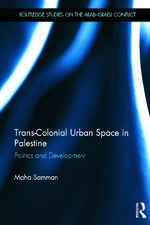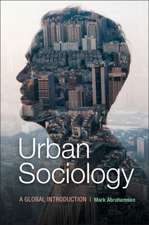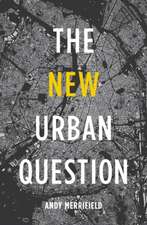City Resilience: Critical Concepts in Built Environment
Editat de Michael Burayidien Limba Engleză Hardback – 22 ian 2015
Preț: 6741.63 lei
Preț vechi: 10212.28 lei
-34% Nou
Puncte Express: 10112
Preț estimativ în valută:
1290.03€ • 1349.63$ • 1071.62£
1290.03€ • 1349.63$ • 1071.62£
Carte tipărită la comandă
Livrare economică 02-16 aprilie
Preluare comenzi: 021 569.72.76
Specificații
ISBN-13: 9780415741842
ISBN-10: 041574184X
Pagini: 1583
Ilustrații: 162
Dimensiuni: 156 x 234 x 142 mm
Greutate: 3.15 kg
Ediția:1
Editura: Taylor & Francis
Colecția Routledge
Seria Critical Concepts in Built Environment
Locul publicării:Oxford, United Kingdom
ISBN-10: 041574184X
Pagini: 1583
Ilustrații: 162
Dimensiuni: 156 x 234 x 142 mm
Greutate: 3.15 kg
Ediția:1
Editura: Taylor & Francis
Colecția Routledge
Seria Critical Concepts in Built Environment
Locul publicării:Oxford, United Kingdom
Public țintă
Postgraduate, Professional, and UndergraduateCuprins
Volume I: The Concept of Resilience
City Resilience Michael Burayidi
Introduction Michael Burayidi
Part 1: Ecological Perspectives
1. Resilience and stability of ecological systems C. S. Holling
2. Ecological resilience – In theory and practice Lance H. Gunderson
3. Resilience thinking: Integrating resilience, adaptability and transformability Carl Folke, Stephen R. Carpenter, Brian Walker, Marten Scheffer, Terry Chapin and Johan Rockström
4. From Metaphor to Measurement: Resilience of What to What? Steve Carpenter, Brian Walker, J. Marty Anderies and Nick Abel
5. Resilience: The emergence of a perspective for social–ecological systems analyses Carl Folke
6. Understanding uncertainty and reducing vulnerability: lessons from resilience thinking Fikret Berkes
7. Adaptation to environmental change: Contributions of a resilient framework Donald R. Nelson, W. Neil Adger and Katrina Brown
8. Linkages between vulnerability, resilience, and adaptive capacity Gilberto C. Gallopín
Part 2: Socio-economic Perspectives
9. Social and ecological resilience: are they related? W. Neil Adger
10. Resilience, Adaptability and Transformability in Social-ecological Systems Brian Walker, C. S. Holling, Stephen R. Carpenter and Ann Kinzig
11. The diversity of resilience: contributions from a social science perspective Daniel F. Lorenz
12. Resilience: A risk management approach Tom Mitchell and Katie Harris
13. The concept of resilience revisited Siambabala Bernard Manyena
14. Vulnerability, resilience and development discourses in context of climate change Terry Cannon and Detlef Müller-Mahn
15. From resilience to resourcefulness: A critique of resilience policy and activism Danny MacKinnon and Kate Driscoll Derickson
Part 3: Human Settlements Perspectives
16. Resilience as a framework for urbanism and recovery Penny Allan and Martin Bryant
17. Resilient cities: meaning, models, and metaphor for integrating the ecological, socio-economic, and planning realms S.T.A. Pickett, M.L. Cadenasso and J.M. Grove
18. Resilience and regions: building understanding of the metaphor Rolf Pendall, Kathryn A. Foster and Margaret Cowell
19. Resistance and resilience – paradigms for critical local infrastructure Christopher D. F. Rogers, Christopher J. Bouch, Stephen Williams et al
20. Resilience: a bridging concept or dead end? Simin Davoudi
Volume II: Resilience and the Built Environment
Introduction Michael Burayidi
Part 4: Design and Urban Form
21. The influence of urban morphology on the resilience of cities following an earthquake Penny Allan, Martin Bryant, Camila Wirsching, Daniela Garcia and Maria Teresa Rodriguez
22. From planning sustainable cities to designing resilient regions D. Bogunovich
23. Urban form and climate change Rafael Pizarro
24. Planning for post disaster resiliency Philip R. Berke and Thomas J. Campanella
25. Integrating hazard mitigation into new urban and conventional developments Philip R. Berke, Yan Song and Mark Stevens
26. Before the war, war, after the war: urban imageries for urban resilience Armina Pilav
27. Urban resilience in post-disaster reconstruction: Towards a resilient development in Sichuan, China Yan Guo
Part 5: Open Space and Critical Infrastructures
28. Protecting vulnerable cities: the UK’s resilience response to defending everyday urban infrastructure Jon Coaffee
29. Urban landscape sustainability and resilience: the promise and challenges of integrating ecology with urban planning and design Jack Ahern
30. Ecological land use complementation for building resilience in urban ecosystems Johan Colding
Part 6: Urban Ecology
31. Urban hazard mitigation: Creating resilient cities David R. Godschalk
32. Ecological resilience in urban ecosystems: Linking urban patterns to human and ecological functions Marina Alberti and John M. Marzluff
33. Urban Transitions: On Urban Resilience and Human-Dominated Ecosystems Henrik Ernstson, Sander E. van der Leeuw, Charles L. Redman, Douglas J. Meffert, George Davis, Christine Alfsen and Thomas Elmqvist
34. Can Resilience Be Reconciled with Globalization and the Increasingly Complex Conditions of Resource Degradation in Asian Coastal Regions? Derek Armitage and Derek Johnson
35. Planning for climate change in urban areas: from theory to practice Christine Wamsler, Ebba Brink and Claudia Rivera
36. Spatial resilience: integrating landscape ecology, resilience, and sustainability Graeme S. Cumming
Part 7: Institutional/Organizational
37. An integrative review of the built environment discipline’s role in the development of society’s resilience to disasters Richard Haigh and Dilanthi Amaratunga
38. Mainstreaming climate change adaptation in Indian cities Divya Sharma and Sanjay Tomar
39. Resilience and organizational institutionalisation from a cross-cultural perspective Matthias Garschagen
Volume III: Social and Economic Dimensions of Resilience
Introduction Michael Burayidi
Part 8: Planning for Resilience
40. A framework for urban climate resilience Stephen Tyler and Marcus Moench
41. Community action planning in East Delhi: a participatory approach to build urban disaster resilience Sunil Prashar, Rajib Shaw and Yukiko Takeuchi
42. Improving adaptive capacity and resilience in Bhutan Harsha Meenawat and Benjamin K. Sovacool
43. Sustainability and resilience: toward a systems approach Joseph Fiksel
44. Managing for local resilience: towards a strategic approach Keith Shaw and Louise Maythorne
45. Metropolitan Planning and Resilience Thinking: A Practitioner’s Perspective Cathy Wilkinson, Libby Porter and Johan Colding
Part 9: Coping Mechanisms
46. Built-in resilience: learning from grassroots coping strategies for climate variability Huraera Jabeen, Cassidy Johnson and Adriana Allen
47. Successful adaptation to climate change across scales W. Neil Adger, Nigel W. Arnell and Emma L. Tompkins
48. Anticipatory Learning for Climate Change Adaptation and Resilience Petra Tschakert and Kathleen Ann Dietrich
49. Resourcing for a resilient post-disaster reconstruction environment Yan Chang, Suzanne Wilkinson, Erica Seville and Regan Potangaroa
50. Are there social limits to adaptation to climate change? W. Neil Adger, Suraje Dessai, Marisa Goulden, Mike Hulme, Irene Lorenzoni, Donald R. Nelson, Lars Otto Naess, Johanna Wolf and Anita Wreford
Part 10: Enhancing Place Resilience
51. "Shared learning" for building urban climate resilience – experiences from Asian cities Sarah Orleans Reed, Richard Friend, Vu Canh Toan, Pakamas Thinphanga, Ratri Sutarto and Dilip Singh
52. From Resilience to Transformation: the Adaptive Cycle in Two Mexican Urban Centers Mark Pelling and David Manuel-Navarrete
53. What is the purpose of urban climate resilience? Implications for addressing poverty and vulnerability Richard Friend and Marcus Moench
54. Resilient regions: re ‘place’ ing regional competitiveness Gillian Bristow
Part 11: Building the Political and Institutional Capacity for Resilience
55. Extreme events and disasters: A window of opportunity for change? J. Birkmann, P. Buckle, J. Jaeger, M. Pelling, N. Setiadi, M. Garschagen, N. Fernando and J. Kropp
56. Rebordering the city for new security challenges: From counterterrorism to community resilience Jon Coaffee and Peter Rogers
57. From practice to theory: emerging lessons from Asia for building urban climate change resilience Anna Brown, Ashvin Dayal and Cristina Rumbaitis Del Rio
58. Public-private partnerships for the development of disaster resilient communities Justine Chen, Ted HsuanYun Chen, Ilan Vertinsky, Lilia Yumagulova and Chansoo Park
59. Understanding urban vulnerability, adaptation and resilience in the context of climate change Harriet Bulkeley and Rafael Tuts
Volume IV: Assessing Vulnerability and Gauging Resilience
Introduction Michael Burayidi
Part 12: Indicators of Community Resilience
60. A place-based model for understanding community resilience Susan L.Cutter, Lindsey Barnes, Melissa Berry, Christopher Burton, Elijah Evans, Eric Tate and Jennifer Webb
61. Measuring capacities for community resilience Kathleen Sherrieb, Fran H. Norris and Sandro Galea
62. Risk and vulnerability assessment: a comprehensive approach Niru Nirupama
63. Disaster resilience indicators for benchmarking baseline conditions Susan L. Cutter, Christopher G. Burton and Christopher T. Emrich
Part 13: Vulnerability Assessment
64. Assessing multifaceted vulnerability and resilience in order to design risk-mitigation strategies Scira Menoni, Daniela Molinari, Dennis Parker, Francesco Ballio and Sue Tapsell
65. Assessing the vulnerability of social-environmental systems Hallie Eakin and Amy Lynd Luers
66. Measuring vulnerability to promote disaster-resilient societies: Conceptual frameworks and Definitions Jorn Birkmann
67. Pinning down vulnerability: From narratives to numbers Daanish Mustafa, Sara Ahmed, Eva Saroch and Heather Bell
68. "Chapter 7: Hazard identification and risk assessment" American Planning Association PAS Report Number 483/484
Part 14: Assessing Social Resilience
69. Assessing the resilience of Delhi to climate-related disaster: a comprehensive approach Sunil Prashar, Rajib Shaw and Yukiko Takeuchi
70. Social vulnerability to environmental hazards Susan L. Cutter, Bryan J. Boruff and W. Lynn Shirley
71. Assessing social resilience Philip Buckle
72. Assessing a community’s capacity to manage change: A resilience approach to social assessment Brigit Maguire and Sophie Cartwright
Part 15: Measuring Ecosystem Resilience
73. Measuring the inertia and resilience of ecosystems Walter E. Westman
74. An exploratory framework for the empirical measurement of resilience G. S. Cumming, G. Barnes, S. Perz, M. Schmink, K. E. Sieving, J. Southworth, M.Binford, R. D. Holt, C. Stickler and T. Van Holt
Part 16: Workbook for Assessing Resilience
75. Assessing resilience in social-ecological systems: Workbook for practitioners Resilience Alliance
City Resilience Michael Burayidi
Introduction Michael Burayidi
Part 1: Ecological Perspectives
1. Resilience and stability of ecological systems C. S. Holling
2. Ecological resilience – In theory and practice Lance H. Gunderson
3. Resilience thinking: Integrating resilience, adaptability and transformability Carl Folke, Stephen R. Carpenter, Brian Walker, Marten Scheffer, Terry Chapin and Johan Rockström
4. From Metaphor to Measurement: Resilience of What to What? Steve Carpenter, Brian Walker, J. Marty Anderies and Nick Abel
5. Resilience: The emergence of a perspective for social–ecological systems analyses Carl Folke
6. Understanding uncertainty and reducing vulnerability: lessons from resilience thinking Fikret Berkes
7. Adaptation to environmental change: Contributions of a resilient framework Donald R. Nelson, W. Neil Adger and Katrina Brown
8. Linkages between vulnerability, resilience, and adaptive capacity Gilberto C. Gallopín
Part 2: Socio-economic Perspectives
9. Social and ecological resilience: are they related? W. Neil Adger
10. Resilience, Adaptability and Transformability in Social-ecological Systems Brian Walker, C. S. Holling, Stephen R. Carpenter and Ann Kinzig
11. The diversity of resilience: contributions from a social science perspective Daniel F. Lorenz
12. Resilience: A risk management approach Tom Mitchell and Katie Harris
13. The concept of resilience revisited Siambabala Bernard Manyena
14. Vulnerability, resilience and development discourses in context of climate change Terry Cannon and Detlef Müller-Mahn
15. From resilience to resourcefulness: A critique of resilience policy and activism Danny MacKinnon and Kate Driscoll Derickson
Part 3: Human Settlements Perspectives
16. Resilience as a framework for urbanism and recovery Penny Allan and Martin Bryant
17. Resilient cities: meaning, models, and metaphor for integrating the ecological, socio-economic, and planning realms S.T.A. Pickett, M.L. Cadenasso and J.M. Grove
18. Resilience and regions: building understanding of the metaphor Rolf Pendall, Kathryn A. Foster and Margaret Cowell
19. Resistance and resilience – paradigms for critical local infrastructure Christopher D. F. Rogers, Christopher J. Bouch, Stephen Williams et al
20. Resilience: a bridging concept or dead end? Simin Davoudi
Volume II: Resilience and the Built Environment
Introduction Michael Burayidi
Part 4: Design and Urban Form
21. The influence of urban morphology on the resilience of cities following an earthquake Penny Allan, Martin Bryant, Camila Wirsching, Daniela Garcia and Maria Teresa Rodriguez
22. From planning sustainable cities to designing resilient regions D. Bogunovich
23. Urban form and climate change Rafael Pizarro
24. Planning for post disaster resiliency Philip R. Berke and Thomas J. Campanella
25. Integrating hazard mitigation into new urban and conventional developments Philip R. Berke, Yan Song and Mark Stevens
26. Before the war, war, after the war: urban imageries for urban resilience Armina Pilav
27. Urban resilience in post-disaster reconstruction: Towards a resilient development in Sichuan, China Yan Guo
Part 5: Open Space and Critical Infrastructures
28. Protecting vulnerable cities: the UK’s resilience response to defending everyday urban infrastructure Jon Coaffee
29. Urban landscape sustainability and resilience: the promise and challenges of integrating ecology with urban planning and design Jack Ahern
30. Ecological land use complementation for building resilience in urban ecosystems Johan Colding
Part 6: Urban Ecology
31. Urban hazard mitigation: Creating resilient cities David R. Godschalk
32. Ecological resilience in urban ecosystems: Linking urban patterns to human and ecological functions Marina Alberti and John M. Marzluff
33. Urban Transitions: On Urban Resilience and Human-Dominated Ecosystems Henrik Ernstson, Sander E. van der Leeuw, Charles L. Redman, Douglas J. Meffert, George Davis, Christine Alfsen and Thomas Elmqvist
34. Can Resilience Be Reconciled with Globalization and the Increasingly Complex Conditions of Resource Degradation in Asian Coastal Regions? Derek Armitage and Derek Johnson
35. Planning for climate change in urban areas: from theory to practice Christine Wamsler, Ebba Brink and Claudia Rivera
36. Spatial resilience: integrating landscape ecology, resilience, and sustainability Graeme S. Cumming
Part 7: Institutional/Organizational
37. An integrative review of the built environment discipline’s role in the development of society’s resilience to disasters Richard Haigh and Dilanthi Amaratunga
38. Mainstreaming climate change adaptation in Indian cities Divya Sharma and Sanjay Tomar
39. Resilience and organizational institutionalisation from a cross-cultural perspective Matthias Garschagen
Volume III: Social and Economic Dimensions of Resilience
Introduction Michael Burayidi
Part 8: Planning for Resilience
40. A framework for urban climate resilience Stephen Tyler and Marcus Moench
41. Community action planning in East Delhi: a participatory approach to build urban disaster resilience Sunil Prashar, Rajib Shaw and Yukiko Takeuchi
42. Improving adaptive capacity and resilience in Bhutan Harsha Meenawat and Benjamin K. Sovacool
43. Sustainability and resilience: toward a systems approach Joseph Fiksel
44. Managing for local resilience: towards a strategic approach Keith Shaw and Louise Maythorne
45. Metropolitan Planning and Resilience Thinking: A Practitioner’s Perspective Cathy Wilkinson, Libby Porter and Johan Colding
Part 9: Coping Mechanisms
46. Built-in resilience: learning from grassroots coping strategies for climate variability Huraera Jabeen, Cassidy Johnson and Adriana Allen
47. Successful adaptation to climate change across scales W. Neil Adger, Nigel W. Arnell and Emma L. Tompkins
48. Anticipatory Learning for Climate Change Adaptation and Resilience Petra Tschakert and Kathleen Ann Dietrich
49. Resourcing for a resilient post-disaster reconstruction environment Yan Chang, Suzanne Wilkinson, Erica Seville and Regan Potangaroa
50. Are there social limits to adaptation to climate change? W. Neil Adger, Suraje Dessai, Marisa Goulden, Mike Hulme, Irene Lorenzoni, Donald R. Nelson, Lars Otto Naess, Johanna Wolf and Anita Wreford
Part 10: Enhancing Place Resilience
51. "Shared learning" for building urban climate resilience – experiences from Asian cities Sarah Orleans Reed, Richard Friend, Vu Canh Toan, Pakamas Thinphanga, Ratri Sutarto and Dilip Singh
52. From Resilience to Transformation: the Adaptive Cycle in Two Mexican Urban Centers Mark Pelling and David Manuel-Navarrete
53. What is the purpose of urban climate resilience? Implications for addressing poverty and vulnerability Richard Friend and Marcus Moench
54. Resilient regions: re ‘place’ ing regional competitiveness Gillian Bristow
Part 11: Building the Political and Institutional Capacity for Resilience
55. Extreme events and disasters: A window of opportunity for change? J. Birkmann, P. Buckle, J. Jaeger, M. Pelling, N. Setiadi, M. Garschagen, N. Fernando and J. Kropp
56. Rebordering the city for new security challenges: From counterterrorism to community resilience Jon Coaffee and Peter Rogers
57. From practice to theory: emerging lessons from Asia for building urban climate change resilience Anna Brown, Ashvin Dayal and Cristina Rumbaitis Del Rio
58. Public-private partnerships for the development of disaster resilient communities Justine Chen, Ted HsuanYun Chen, Ilan Vertinsky, Lilia Yumagulova and Chansoo Park
59. Understanding urban vulnerability, adaptation and resilience in the context of climate change Harriet Bulkeley and Rafael Tuts
Volume IV: Assessing Vulnerability and Gauging Resilience
Introduction Michael Burayidi
Part 12: Indicators of Community Resilience
60. A place-based model for understanding community resilience Susan L.Cutter, Lindsey Barnes, Melissa Berry, Christopher Burton, Elijah Evans, Eric Tate and Jennifer Webb
61. Measuring capacities for community resilience Kathleen Sherrieb, Fran H. Norris and Sandro Galea
62. Risk and vulnerability assessment: a comprehensive approach Niru Nirupama
63. Disaster resilience indicators for benchmarking baseline conditions Susan L. Cutter, Christopher G. Burton and Christopher T. Emrich
Part 13: Vulnerability Assessment
64. Assessing multifaceted vulnerability and resilience in order to design risk-mitigation strategies Scira Menoni, Daniela Molinari, Dennis Parker, Francesco Ballio and Sue Tapsell
65. Assessing the vulnerability of social-environmental systems Hallie Eakin and Amy Lynd Luers
66. Measuring vulnerability to promote disaster-resilient societies: Conceptual frameworks and Definitions Jorn Birkmann
67. Pinning down vulnerability: From narratives to numbers Daanish Mustafa, Sara Ahmed, Eva Saroch and Heather Bell
68. "Chapter 7: Hazard identification and risk assessment" American Planning Association PAS Report Number 483/484
Part 14: Assessing Social Resilience
69. Assessing the resilience of Delhi to climate-related disaster: a comprehensive approach Sunil Prashar, Rajib Shaw and Yukiko Takeuchi
70. Social vulnerability to environmental hazards Susan L. Cutter, Bryan J. Boruff and W. Lynn Shirley
71. Assessing social resilience Philip Buckle
72. Assessing a community’s capacity to manage change: A resilience approach to social assessment Brigit Maguire and Sophie Cartwright
Part 15: Measuring Ecosystem Resilience
73. Measuring the inertia and resilience of ecosystems Walter E. Westman
74. An exploratory framework for the empirical measurement of resilience G. S. Cumming, G. Barnes, S. Perz, M. Schmink, K. E. Sieving, J. Southworth, M.Binford, R. D. Holt, C. Stickler and T. Van Holt
Part 16: Workbook for Assessing Resilience
75. Assessing resilience in social-ecological systems: Workbook for practitioners Resilience Alliance
Descriere
This four-volume collection brings together the most important canonical and cutting-edge thinking in planning and city resilience. This is the largest coherent academic reference work to date in this growing field.























